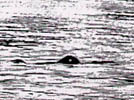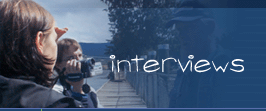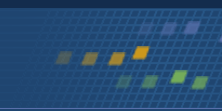 Interviews Interviews
Ken Chaplin
Ken Chaplin, however, was after the real thing.
On the evening of July 18, standing on the same low bluff where Clem had stood nine days before. Chaplin took the first of four videotaped sequences of what he says is an Ogopogo. This is what he recorded: In the foreground, their eyes toward the camera, three children play just offshore in a rubber raft. They are unaware that behind them, silhouetted in the sunlight's coruscations, a blackish thing swims towards the right, maybe 50 meters away. The creature moves out of sight, disappearing behind some bushes. That is all. In fact, Chaplin claims he saw much more in the minutes that immediately followed, but in his excitement over seeing Ogopogo, he had inadvertently left the camera running, recording a topsy-turvy, blurred dash through the shoreline poplars. When he'd finally caught up with the animal again, he'd mistakenly pushed the standby button, freezing, he says, what would have been a clear sequence showing the monster's reptilian head and its huge, mottled, snakelike body.
The second and most dramatic sequence, recorded the next evening aboard Chaplin's six-meter-long inboard motorboat, shows this: A low, blackish shape swims to the left, its head slightly raised. Its shoulders and tail are also visible. The wake from its movement is unmistakable. It turns towards the camera, appears to see Chaplin's boat, turns again and in a lightning fast motion flicks its tail upward, then smacks the water in a downward flick as it rolls underwater. That, too, is all. Chaplin says that on this occasion some children on the shore in the background were pointing and shouting, "Ogopogo!"
It is in replay, moving the tape from frame to frame during the most impressive few seconds, that two curious things are revealed. First, where the tail joins the body, it widens into a muscular hind-end. And second, as the animal dives, two appendages -perhaps webbed feet- kick backward amidst the splash of water.
There are two other short, taped sequences from following days, but neither is as interesting as the second segment.
There is not an iota of doubt in my mind that what I'm watching on Chaplin's video monitor is something real, something alive. The animal's movements are convincing. But with the backlighting, the lack of scale, the graininess of the 8 mm videotape, and the amateur nature of the taping -Chaplin had never used a video camera before- it's impossible through normal viewing to deduce what is swimming on Okanagan Lake. It rests on Chaplin and his parents' word -for they saw it closest- that the thing was five meters long, snakelike, and green. The other seven who saw it with the Chaplin's, all family members or friends, had -with one exception- less clear views. The exception is 72 years old Horace Simpson, a longtime acquaintance and the former owner of Kelowna's largest forest-products mill. He watched it through binoculars on July 21, and says unhesitatingly that it's the length Clem and Ken say it is.
Ken Chaplin now found himself in a difficult position. He had a videotape that he believed proved Ogopogo's existence. He also had a job selling cars. He went to his boss and showed him a segment of the videotape, hoping to get a few weeks off to do some more photography. Bill Harbottle saw a black shape and was unimpressed with the video, and doubly unimpressed with the idea that Chaplin should go hunting for a mythic creature. He told Chaplin to decide: Toyotas or Ogopogo.
Chaplin agonized. His mother said: go back to work. So did most friends. His father said: get more pictures. Chaplin didn't have any money. He'd learned the $1 million reward offered by the region's tourism board was for the capture of a live Ogopogo and, even then, the offer had expired four years earlier. He decided, however, to leave Hilltop Toyota. He also decided to keep the whole thing secret until he got some more pictures. He didn't want any competition.
"It sounds ridiculous, doesn't it?" says Chaplin, reflecting little later on the decision that would change his life. "I mean, if someone had told me a few months ago that I'd quit my job and get carried away by Ogopogo. I'd have said, "You're crazy!" I wouldn't have believed it. Little did I know old Ogopogo was going to come along and suck me right in... turn my life upside-down." And he laughs, his blue eyes merry. Then, he adds conspiratorially, "I'd much rather do this than sell cars." At that, he laughs even louder.
He accepted his parents' offer to move in with them. As Chaplin recounts: "Dad opened a bank account in my name. He said, "Let's be partners." We thought someone would come in and we'd have a quick sale of the videotape and split the profits. It wasn't that easy. It became like a marketing thing, a business. Dad wanted to be in on all the decisions. We quarreled over small things -the cost of getting a print of photo made. He saw money going out and no money coming in. It was extremely frustrating. "Chaplin grimaces at the memory.
Even worse: Chaplin continued to return quietly to the mouth of Bear Creek at dawn and dusk every day for two weeks following the initial sighting. He kept these excursions clandestine for fear others might discover what he was up to and get Ogopogo pictures of their own. But Ogopogo, it seemed, had disappeared. Chaplin never saw it again. Having left his job, he felt terribly disappointed.
To complicate matters even more, on July 28, four Vancouver-based members of the B.C. Cryptozoology Club -cryptozoologists study unexplained creatures- arrived unannounced on the shore of Okanagan Lake, 60 kilometres south of Bear Creek. Within 20 minutes of their appearance, they claimed to have spotted a blackish, six-humped, 12 meters long creature swimming on the surface. Two days later, they reported a second sighting.
When Chaplin heard about this, he was thunderstruck. He had competition! He wondered if he were about to be scooped. He spied on the interlopers. He criticized them privately as gullible and media-hungry. It no doubt annoyed him that they were getting press coverage with their two unverified sightings. He, with his videotape, had, so far, nothing but bills.
"I felt the cryptozoologists were getting in my way." Chaplin admits. "It was my videotape. It was -with Dad and Mom- my discovery. It was my quest. I wanted to bridge the public credibility gap with photographic proof of Ogopogo -with me as the focus of attention, not the cryptozoologists."
So he called a press conference for August 10. The mayor of Kelowna, Jim Stuart, came. So did 10 journalists. Arlene Gaal, a 52 years old Kelowna resident and author of two books on Ogopogo, said Chaplin's videotape was a Rembrandt. "It's the best image ever taken of any unknown species," she declared. "It beats any picture of Loch Ness's Nessie. The Chaplin video cannot be a fake. The animal's moving. There's no doubt we're looking at an animal that hasn't been classified yet." Chaplin then ran the critical second segment of the video. Some people in the audience gasped when the creature turned, slapped its tail onto the water, and dove. Later, under questioning, he acknowledged he hoped to make some money selling the tape. Barry McDivitt, a broadcaster for the local TV station, observed the proceedings with a jaundiced eye. He didn't like the sound of someone capitalizing on Ogopogo. He slid a note to the mayor seated next to him which read: "It looks sort of like a beaver." Mayor Stuart whispered back, "It looks more like a crocodile."
On air the next day, McDivitt introduced the news item on the sighting derisively as "another Ogopogo story". Then, he dismissed Chaplin's creature with the words, "It looked sort of like a dog." In the following days, McDivitt aired two more sceptical reports about the tape. Chaplin felt betrayed.
And he felt doubly betrayed by his erstwhile supporter, Arlene Gaal. She told him that she'd given the TV station's reporter a picture she'd taken in his presence which Chaplin knew was of one of the beavers that live in Bear Creek, but that she said could be a photo of Ogopogo. Although Gaal had argued that whatever it was, the further publicity it generated could only help Chaplin's cause, Chaplin was furious. Gaal was undercutting him. She was threatening his credibility. She was crowding into his spotlight. His hopes to Grow Rich with Peace of Mind were rapidly unraveling. He asked Gaal to recant. She wouldn't. He phoned the TV station himself and informed the management that Gaal's photo was of a beaver. Creek, but that she said could be a photo of Ogopogo. Although Gaal had argued that whatever it was, the further publicity it generated could only help Chaplin's cause, Chaplin was furious. Gaal was undercutting him. She was threatening his credibility. She was crowding into his spotlight. His hopes to Grow Rich with Peace of Mind were rapidly unraveling. He asked Gaal to recant. She wouldn't. He phoned the TV station himself and informed the management that Gaal's photo was of a beaver.
Chaplin was front-page news in Kelowna, but he couldn't help noticing that whenever his name was mentioned. he was always referred to as "a car salesman", a phrase he knew carried the vague stigma of "untrustworthy".

|


